Module 4: Teamwork and Communication: Facilitator Notes
AHRQ Safety Program for Long-Term Care: HAIs/CAUTI
Slide 1: Module 4: Teamwork and Communication

Say:
The Teamwork and Communication module will discuss how safety teams in nursing homes can understand and practice successful teamwork and effective communication to improve the resident safety culture in their facility.
Slide 2: Objectives

Say:
In this module we will—
- Describe effective communication and teamwork.
- Describe why teamwork training and improved communication optimizes resident safety.
- List barriers, tools, and strategies to effective teamwork and communication.
- Describe selected teamwork and communication tools.
- Review solutions to teamwork and communication challenges.
Slide 3: Effective Teamwork and Communication1,2

Say:
Positive, two-way communication promotes teamwork and improves resident safety culture. According to an article in the Journal of Sociological Research, quote, "The more who feel they are asked for their input in doing their jobs and are told what they need to know to successfully do their jobs, the more likely staff members will be inclined to help others in doing their jobs as well as receive help from others. When these qualities of work are realized, stress is felt as less excessive. The more satisfied the long-term care workforce, the higher quality of care that is delivered to the patients."
Because improved teamwork and communication is proven to increase resident safety, investing in teamwork training for nursing home staff is important. The most critical teamwork competency is effective communication. Team members must be taught to value teamwork and the trusting relationship on which it is based. They must know and be able to use effective strategies to enhance communication.
When critical information is being exchanged, for example during a transition in resident care, the importance of communication becomes apparent. When a patient is being transferred from the hospital to a nursing home or during a change of shift report, vital pieces of information can be omitted, placing the resident at risk for an error in their care. In 2002, a Joint Commission report on medical errors stated that 70 percent of these errors resulted from breakdowns in communication.
1. Fuqua RM. Long term care nurses' feelings on communication, teamwork and stress in long term care. Journal of Sociological Research. 2013;4(2):61.
2. Salas E, Frush K. Improving Patient Safety Through Teamwork And Team Training. Oxford: Oxford University Press; 2012.
Slide 4: What Is Effective Communication Among Staff?3

Say:
Communication is a process by which information is exchanged between individuals, departments, or organizations. What is effective communication? Communication is effective when a message is—
- Received
- Understood as intended.
- Shared at the appropriate time to support the safest care for the resident.
3. TeamSTEPPS Long-Term Care Toolkit. Rockville, MD. Agency for Healthcare Research and Quality; October 2012.
Slide 5: Why Is Effective Communication Among Staff Important?4

Say:
Why is effective communication among staff important? When critically important information is not effectively communicated, the results can lead to mistakes and potential resident harm. An example is if a staff member caring for a resident noticed some subtle changes in their health status but did not document this information or share it verbally with their team or the oncoming staff at shift change. These subtle changes may represent the beginning signs of an infection, like a catheter-associated urinary tract infection, or CAUTI. Effective communication could have helped identify a diagnosis and treatment earlier and decreased harm to the resident.
When staff, residents, and family members have mastered effective communication, everyone on the team feels they are contributing to the care of the resident. Compare this with the scenario of ineffective communication that could result in a medication error or other mistake that can cause real harm to the resident. In this scenario, the resident and family suffer and may lose trust in their caregivers, and staff may experience stress as a result of the impact of ineffective communication.
4. CUSP Toolkit. Rockville, MD: Agency for Healthcare Research and Quality; December 2012.
Slide 6: Staff Communication

Say:
Let's watch a demonstration of effective communication between a certified nursing assistant and a facility nurse.
PLAY VIDEO:
Video 1.1: Staff Communication
Ask:
What elements of effective communication did you see in the video?
Slide 7: Barriers, Tools and Strategies, and Outcomes for Communication

Say:
Have you heard of the TeamSTEPPS program? It's an education program that teaches communication skills for teams. The program was first used in the military and was then used successfully in many health care environments. The following table from the TeamSTEPPS Long-Term Care program highlights barriers to communication and the communication tools and strategies that teams can use to improve outcomes. We will review a number of these tools and strategies in detail in the coming slides.
Ask:
What barriers can you identify that may exist in your facility?
Say:
Examples that have been shared by other long-term care facilities include: institutional barriers to communication, understaffing, a culture in which speaking up is not supported, staff turnover, inadequate (teamwork and communication) training, verbal abuse, fatigue, heavy workloads, and ambiguous instructions. Other barriers to effective communication may involve a lack of a resident safety culture in the facility. Facilities that promote a culture committed to resident safety encourage staff to speak up if they become aware of a safety concern and create an environment in which staff feel comfortable and safe to communicate resident safety concerns. A culture of safety fosters trust that team members will respectfully listen and respond appropriately to the information they share.
Slide 8: TeamSTEPPS Communication Concepts3

Say:
The TeamSTEPPS program for long-term care teaches the following tools to help health care teams improve their communication with one another:
- Brief
- Huddle
- Debrief
- SBAR
- CUS
- DESC
We will briefly describe each of these communication tools in the following slides.
3. TeamSTEPPS Long-Term Care Toolkit. Rockville, MD. Agency for Healthcare Research and Quality; October 2012.
Slide 9: For Planning – The Brief

Say:
The Brief is a short meeting during which all staff caring for a resident can discuss concerns, issues or expectations of the day and then make specific plans to address the concerns, issues, and expectations. A Brief usually occurs at the beginning of the shift and is designed to help all team members develop a shared understanding about the resident's plan of care for the day. This shared understanding creates a sense of teamwork and collaboration and provides an opportunity for team members to speak up if they have concerns. For example, they might discuss the resident's decreasing mobility and the risk for falls. The team could then make a plan to keep the resident from falling by providing a walker and teaching the resident to use the walker safely or explaining to the resident when to contact the staff for help with getting out of bed. The Brief ensures everyone understands the resident's needs and expectations, helps the team avoid surprises that could affect the resident's care, provides an opportunity for every team member to participate, and sets the tone for the day.
Tool: Page 110 of the Team Training book, Briefing Template---adapt this tool for long-term care
Ask:
Does your team have a time when Briefs would be helpful? What times would you identify? Morning report? Handoffs for lunch-break coverage?
Slide 10: Brief Checklist

Say:
Let's watch this short video depicting how a Brief is conducted.
Briefing Video
AFTER the viewing, ASK:
Does your staff work in teams? If so, do these teams conduct Briefs to review any safety or care concerns? What does it look like? Where is it done, who attends, how long does it take, and are there tools to document the conversation?
Slide 11: For Problem Solving – Huddle

Say:
Huddles are short, ad hoc meetings between two or more team members designed to ensure everyone who needs to know is aware of the current situation and is part of a shared response to the situation. A Huddle is used in cases where the conditions for the resident, staff, or facility have changed since the last time the team met. A Huddle allows a team to assess the impact of the change on the team's ability to perform duties and to adjust plans as needed to be sure all duties can be performed.
Let's say a resident becomes acutely ill and needs one-on-one care in preparation for transfer to a hospital. Staff members caring for that resident should be assigned fewer residents, which means another team member must care for those residents. A Huddle allows the team to quickly meet to discuss the situation, its effect on workload, and the necessary reassignments. It allows information to be shared with everyone involved, explains why assignments are being changed, and alerts staff to the safety needs of the unstable resident.
Another example of the use of a Huddle is the morning Safety Huddle, where a leader, such as a charge nurse, calls the team together to discuss the safety needs the staff have identified for their assigned residents. This can include a review of residents with an indwelling urinary catheter, the approved indication for the catheter, and the continued need for it.
Say:
Let's watch this short video depicting how a Huddle is conducted.
Huddle Video
AFTER the viewing, ASK:
Does your facility currently use Huddles? What work situations have you experienced when a Huddle would have been helpful?
Slide 12: For Process Improvement – Debrief
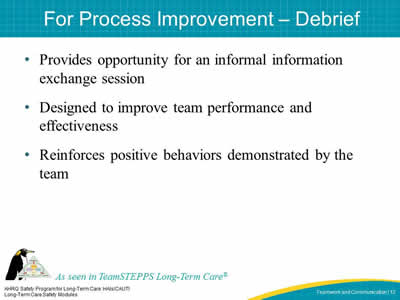
Say:
A Debrief is an informal but structured discussion of an event after it occurs. The Debrief meeting is ideally conducted with all team members that were involved in the event. The discussion is focused only on teamwork issues and is designed to improve performance and effectiveness. A Debrief is a good time to reinforce positive behaviors demonstrated by the team.
Slide 13: Debrief Checklist
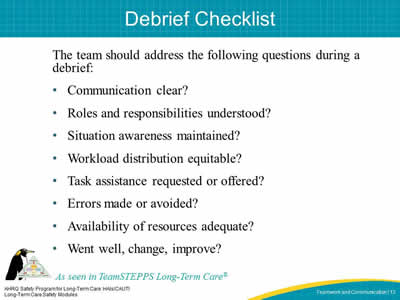
Say:
The team's discussion during a Debrief can be facilitated by using a checklist using the following questions as a guide:
- Was communication clear?
- Roles and responsibilities understood?
- Situation awareness maintained?
- Workload distribution equitable?
- Task assistance requested or offered?
- Errors made or avoided?
- Availability of resources adequate?
- What went well, and could be changed or improved?
Slide 14: Communication Tools

Say:
Let's watch an example of a Debrief used by a team at a long-term care facility. Pay attention to the questions the team addresses.
PLAY VIDEO:
Video 1.4 Communication Tools
Ask:
Do you think this Debrief helped the team? How can you incorporate Debriefs at your facility?
Slide 15: For Information Exchange – SBAR
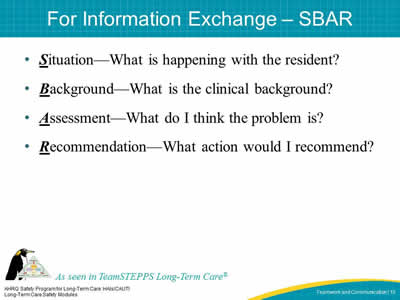
Say:
Has anyone here ever heard of SBAR? Anyone used it before?
The SBAR technique provides a standardized way for team members to concisely communicate about a resident's condition. Standards of communication are essential for developing teamwork and a culture of resident safety. SBAR is an easy-to-remember way to frame any conversation, especially a critical one that requires immediate attention and action. It provides team members with an easy and focused way to set expectations for what will be communicated and how. In phrasing a conversation with another member of the team, consider the following:
- Situation—What is happening with the resident?
- Background—What is the clinical background?
- Assessment—What do I think the problem is?
- Recommendation—What action would I recommend?
SBAR provides a vehicle for individuals to speak up and express concern in a concise manner in both clinical and nonclinical settings and departments.
Slide 16: Practicing SBAR3
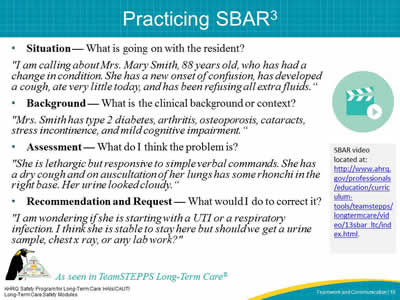
Say:
Let's review how to properly use SBAR. In this video, the resident's condition has worsened, resulting in a telephone call to the attending physician. Watch the video to see the transfer of information using SBAR.
PLAY VIDEO: SBAR Video
Ask:
How did SBAR improve the information exchange between the nurse and physician?
- The nurse identified herself and the reason she was calling.
- The physician was quickly made aware of Mrs. Smith's deteriorating situation.
- The nurse provided the background of the diagnosis and all current labs.
- The nurses' assessment of the resident frames the concerns that prompted the nurse to call the physician.
- The recommendations for additional labs and a revised plan of care was clearly communicated by the nurse.
Ask:
Think of a situation involving your work in a nursing home. Remember a time when you needed to communicate to another team member about a resident situation. Following the SBAR format, practice communicating the necessary information as efficiently or succinctly as you can.
3. TeamSTEPPS Long-Term Care Toolkit. Rockville, MD. Agency for Healthcare Research and Quality; October 2012.
Slide 17: For Information Transfer – Handoffs
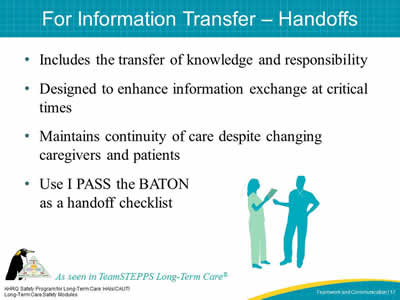
Say:
Handoffs occur during a change in assignment for the responsibility of caring for a resident. A handoff may occur when a resident is first welcomed to the nursing home from the hospital or during a shift change. When a resident's care is turned over to another staff member, even for a short timespan such as a lunch break, a structured communication should occur to provide the oncoming staff member essential information about the resident. This important communication process increases resident safety by preventing the omission of important details about the resident's needs. Sometimes staff use a handoff form to effectively and efficiently convey the needed information.
Remember, a handoff can also be used in nonclinical settings and departments.
Ask:
When do you typically use handoffs? How are handoffs handled on your unit or department? How are other members of the nursing home notified when assignments change? Is a standardized form such as the 24-hour report used to convey information on the resident's status?
Slide 18: Handoff Tools
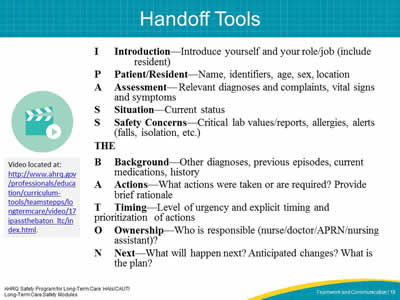
Say:
"I Pass the Baton" is one option for structured handoffs during transitions of care. Each of the elements is briefly described below:
| I | Introduction—Introduce yourself and your role/job (include resident) |
| P | Patient/Resident—Provide name, identifiers, age, sex, location |
| A | Assessment—Describe relevant diagnoses and complaints, vital signs, and symptoms |
| S | Situation—Describe current status (such as active daily living status, intake/appetite, elimination, behavior, cognition), including code status, level of uncertainty, recent changes, response to treatment |
| S | Safety Concerns—Provide critical lab values/reports, allergies, alerts (falls, isolation, etc.) |
THE
| B | Background—Provide other diagnoses, previous episodes, current medications, history |
| A | Actions—What actions were taken or are required? Provide a brief rationale for each action. |
| T | Timing—Describe the level of urgency and explicit timing and prioritization of actions |
| O | Ownership—Who is responsible (nurse/doctor/APRN/nursing assistant)? Include resident/family responsibilities for care |
| N | Next—What will happen next? Anticipated changes? What is the plan? Are there contingency plans? |
Let's review how to properly use I PASS the BATON. In this video, the nurse is providing shift change report for an unstable resident.
PLAY VIDEO: I PASS the BATON Video
Ask:
How was I PASS the BATON used in this nurse to nurse example?
Slide 19: Speaking Up Using Structured Language
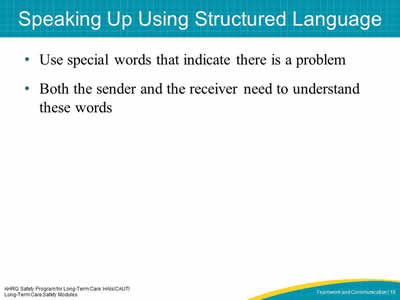
Say:
Another way to effectively communicate among all team members is to use structured language. Structured language uses keywords as "red flags" to prompt team members that something important is being said and all team members should pay attention. This type of communication can also be used to increase the speed at which information is shared. It is important that both the sender and the receiver understand the words that are used during structured language communication.
Slide 20: CUS
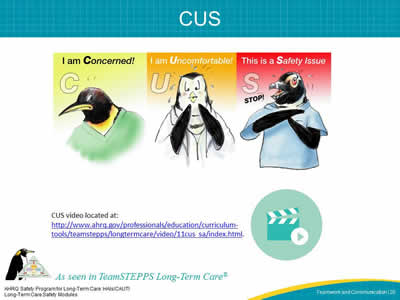
Say:
"CUS" is one type of structured language. How many of you have had the experience of telling someone something important but you believe they may not hear you because they are busy or distracted by other tasks or people while you are trying to convey an important message? CUS is one method that can be used to be sure your message is heard. CUS stands for the three words:
- Concerned: I am Concerned!
- Uncomfortable: I am Uncomfortable!
- Safety: This is a Safety issue!
When staff are trained to use the CUS tool, they become conditioned to listen when they hear these three keywords. CUS can be used as one way to "Stop the line" when something unsafe is about to happen to a resident.
Let's watch this short video depicting how to use CUS.
PLAY VIDEO: CUS Video
Ask:
What did you learn from watching staff use CUS?
Slide 21: DESC
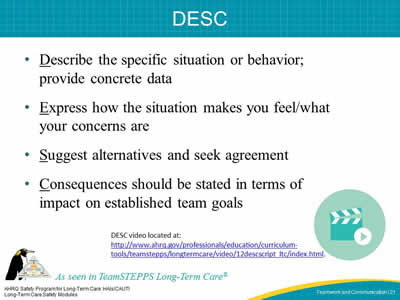
Say:
DESC is another structured communication tool that has the following components:
- Describe what is happening.
- Express what you are concerned about.
- Suggest other actions and agreement.
- Consequences described are stated in terms of impact on your team's goals.
Let's watch this short video depicting how to use DESC.
PLAY VIDEO: DESC Script Video
Ask:
Can anyone think of a time when using a tool such as DESC would have improved communication in your facility?
Slide 22: Communication Strategies for Use With Residents and Family Members
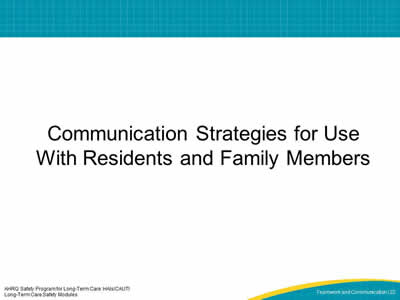
Say:
Next we will discuss some specific communication strategies you may want to use when communicating with residents and family members.
Slide 23: Why Is It Important?

Say:
Excellent communications with residents and their families can positively affect resident outcomes, perceptions of quality, and resident safety. One important example of effective communication in nursing homes is when staff actively engage residents and their family in developing a plan of care. When staff involve residents and families in the resident's care planning, the resident is more likely to experience higher levels of satisfaction and also follow their care plan. All of these actions improve relationships and increase teamwork, which can lead to improved clinical outcomes and quality of life for residents and their family members.
Slide 24: What Is Effective Communication Between Staff and Residents and Family?
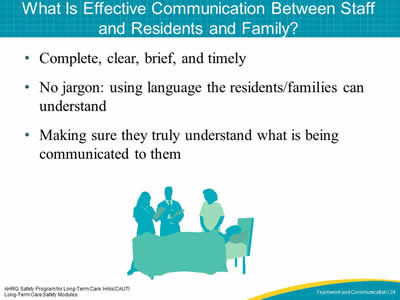
Say:
Effective communication between staff and residents and family starts with providing complete, clear, brief, and timely communication. To effectively communicate with residents and their family, staff need to use nonmedical, easily understood words in the language the resident and family members understand best. There are many ways staff can make sure residents and their family understand what is being communicated, including teach-back. Teach-back is a method of providing education in small steps and stopping to ask the listener to repeat what was heard. This allows the staff member to assess comprehension of the content provided. The staff member can clarify any questions the resident/family may have and repeat the most important points. If there is critical information for the resident and family to understand, it is best to provide the information in written form using the language they can best read or use whatever communication method that works and is most effective for the resident and their family.
Slide 25: Communication and Engaging the Family
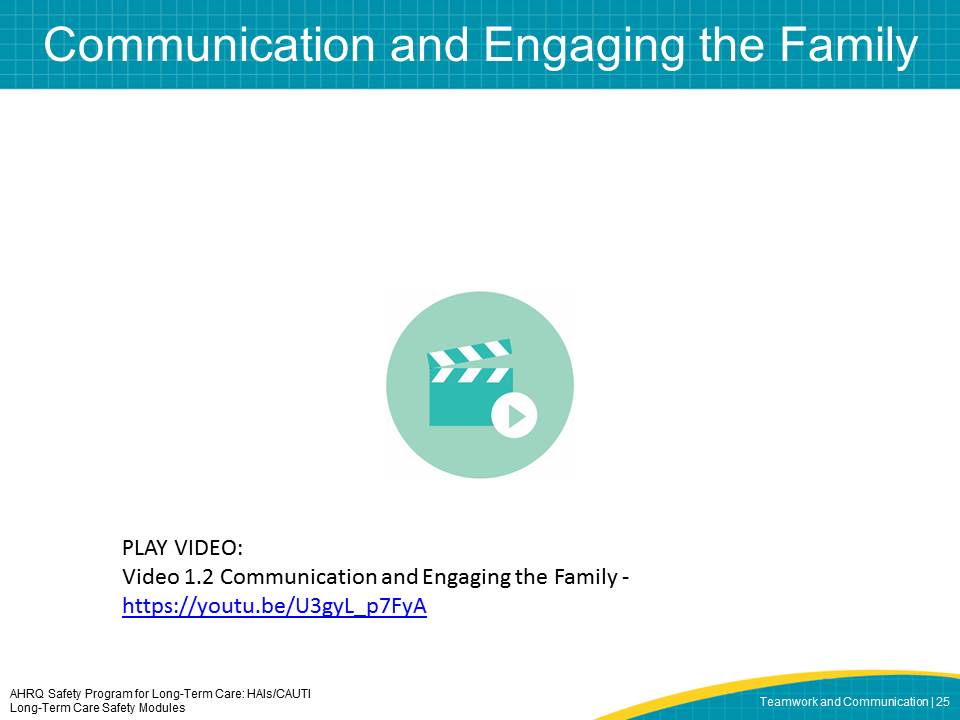
Say:
The following video shows a facility nurse and a certified nurse's assistant engaging a family member in conversation around the family member's concerns.
PLAY VIDEO:
Video 1.2 Communication and Engaging the Family
Ask:
Was the nurse's communication complete, clear, brief, and timely? Does the family member understand what is being said? How did the nurse ensure that the family member's needs are or will be addressed?
Slide 26: Addressing Challenges
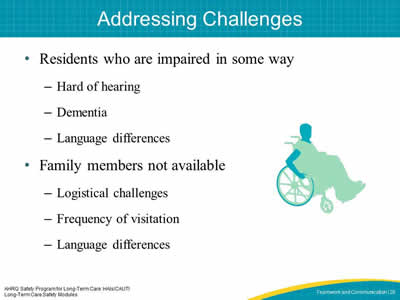
Say:
Communication between staff and residents and their family members is challenging for many reasons, some of which are listed on this slide. It is important for the safety team to identify and address these challenges to prevent any breakdown in information sharing and understanding.
Ask:
What challenges do you have in your facility that could affect information sharing with residents and their families? What are some ways your facility can address these challenges?
Slide 27: Barriers to Speaking Up for Staff, Residents, and Families
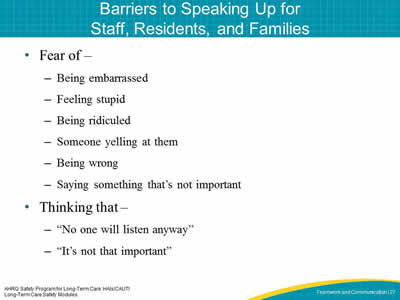
Say:
There are also barriers to speaking up that many staff and residents and family have noted. Fear is cited as the main reason people fail to speak up when they should. These fears can include the fear of feeling embarrassed, or being ridiculed, or being wrong. Many of these fears can be eliminated by simply inviting and encouraging every team member to speak up! Thanking those who do speak up can also reinforce that speaking up to improve resident safety is the new expectation. Families should also be encouraged to speak up and to be a partner in the resident's care. You can demonstrate support for family as partners by inviting them to join rounds, or to be part of the decision-making discussions with physicians and staff. Encouraging the residents and family to ask questions, and offering positive reinforcement when they do, will ensure that they will continue to be engaged and not afraid to ask questions or provide input.
Slide 28: Communicating Adverse Events
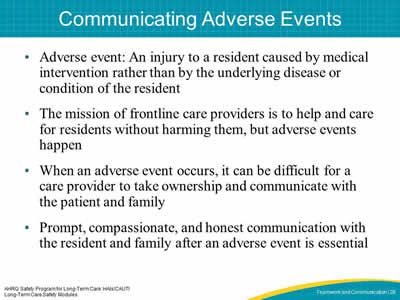
Say:
Communication following an adverse event can been especially challenging. An event is an injury to a resident that is caused by a medical intervention rather than by the underlying disease or condition of the resident. Each facility has policies and procedures to follow after an adverse event occurs, and most involve working with a risk management professional. These procedures should minimally include the care providers following these steps:
- Provide care. Caring for the resident's physical needs after an event is the first step a provider must take.
- Report. Providers report the incident to the unit manager, resident's medical care provider, and the risk management department according to the facility's incident reporting policy.
- Communicate. Follow facility policy about who, when, and where the information is shared with the resident/family. Providers should communicate the facts of what happened and assure the patient and family that they will receive new information as it is discovered. It can sometimes be difficult for care providers to take ownership and communicate with the resident and/or family. However, prompt, compassionate, and honest communication following an event is essential. And remember, communication is an ongoing process that occurs from initial reporting of the incident through investigation and resolution.
Slide 29: Disclosure and Apology for Unexpected Adverse Outcomes
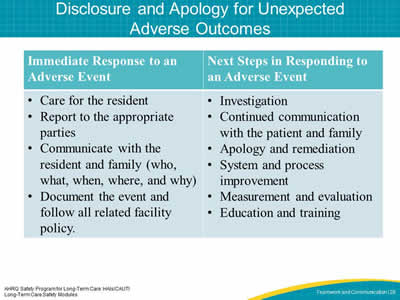
Say:
During the initial communication with the resident and family, providers should—
- Communicate only relevant facts that are reasonably certain at the time because further investigation and resolution may be necessary.
- Advise the resident and family that communication will be ongoing as followup investigation occurs.
- Advise the resident and family that a designated contact person (usually the nurse manager) is available for their questions and concerns.
- Document in the medical record the facts of the incident and any care the resident received as a result of the incident. The discussion with the resident and family should be documented by providers, and the documentation should include an objective description of the event, the resident's response to the event, and the care provided as a result of the event.
When an incident occurs, the facility should investigate and analyze it (for example, conduct a root cause analysis) to determine if resident harm occurred. When the facility determines that unreasonable care was provided, the following information should be communicated to the resident and family:
- An apology for any unreasonable care.
- An explanation of what happened.
- A meaningful discussion of projected outcomes.
- An early offer of remediation (such as waiving bills) and compensation.
- The facility should use information learned from the investigation to identify and implement system and process improvements. The facility should track, trend, and analyze event data for quality assurance and other identified purposes. The facility should also establish initial and continual training requirements for professional, administrative, and support staff.
Slide 30: How To Communicate About An Adverse Event
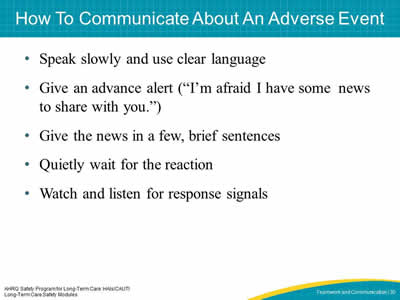
Say:
It is important to remember that residents and family members can experience a number of emotions when an adverse event occurs, so communication about an adverse event should be compassionate and sensitive. The care provider should speak slowly and use clear language. The provider should begin with an alert, such as, "I'm afraid I have some news I need to share with you," and then provide the information in a few short sentences. The provider should wait for a response and listen carefully to any concerns shared by the resident and/or family. The facility should be prepared to address the concerns and, if committed to transparency, offer an apology that the incident happened.
Slide 31: Communication in Action
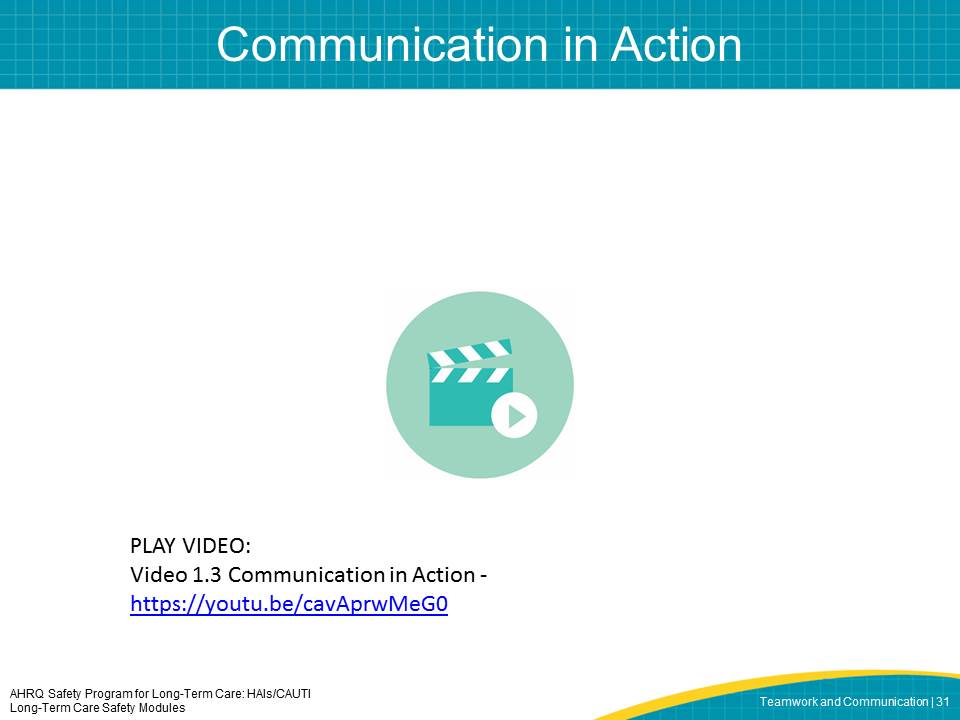
Say:
We have now reviewed the different tools to promote effective communication among staff, residents, and families. We have also discussed potential barriers and strategies to address communication challenges. The video shows how these tools come together in helping teams communicate more effectively to improve the care of residents.
PLAY VIDEO:
Video 1.3 Communication in Action
Ask:
What tools did the team in the video above use? How did communication with the resident's family help improve the care for all residents at the facility? Do you and your facility team use any of the same communication tools?
Slide 32: Key Concepts Review
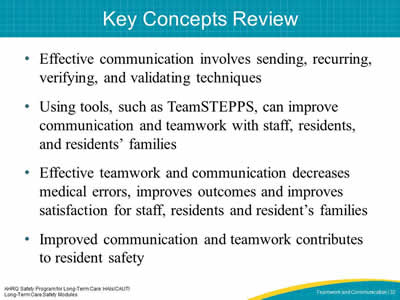
Say:
We have covered many examples of effective communication skills and tools that can be used by nursing home staff and residents and families to improve teamwork and communication. You have heard about the TeamSTEPPS tools for Long-Term Care Facilities that staff can learn and use to enhance a culture of resident safety. The safety team involved in this program can use these tools and strategies to teach and evaluate staff communication and track improvements in resident safety.
Slide 33: References
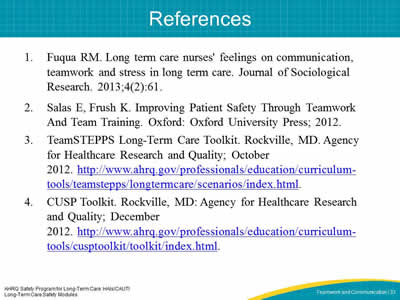
- Fuqua RM. Long term care nurses' feelings on communication, teamwork and stress in long term care. Journal of Sociological Research. 2013;4(2):61.
- Salas E, Frush K. Improving Patient Safety Through Teamwork And Team Training. Oxford: Oxford University Press; 2012.
- TeamSTEPPS Long-Term Care Toolkit. Rockville, MD. Agency for Healthcare Research and Quality; October 2012.
- CUSP Toolkit. Rockville, MD: Agency for Healthcare Research and Quality; December 2012.



